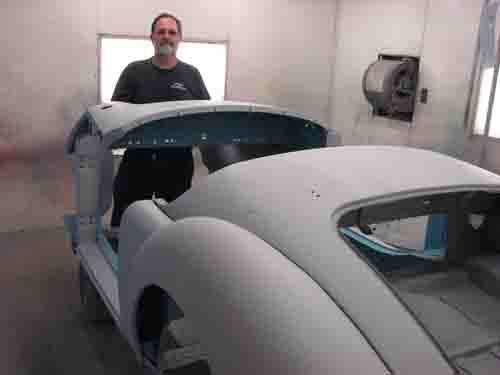Why You Should Not Undercoat Your Car

 As a young man of forty I bought my first MGA and did a frame on restoration. I enjoyed this project and decided that when I retire I wanted to keep busy and these cars would be a good hobby. I started to look for the cars and ended up with eighteen cars and five parts cars when I retired.
As a young man of forty I bought my first MGA and did a frame on restoration. I enjoyed this project and decided that when I retire I wanted to keep busy and these cars would be a good hobby. I started to look for the cars and ended up with eighteen cars and five parts cars when I retired.
I have been retired for about six years and I got rid of most of the parts cars and am down to thirteen cars. I was told one time by a person who owned a large restoration shop that you can not make money working on you own cars. You can, however, make money restoring and working on other people’s cars. Well I am not ready to start another business so I am working and playing on my cars. I haven’t made much money but so far I haven’t lost any.
Getting back to the title to this article. The last two MGAs that I have restored were under coated and tarred extensively. One of them looked like the man must have been a roofer. He had put tar on everywhere he could and it looked like he put it on with a putty knife. He even coated inside the doors, under the bonnet, boot, fenders and frame – everywhere he could get the tar to stick.
Here is a tip. When taking tar off with a torch and scraper, wear heavy gloves because when that tar melts and falls on your hands it burns into the skin.
The car I am working on now the guy even put tar under the hood. On the inner fenders, the X pan and the heater shelf. What a mess this stuff is to get off. My method is a torch with a scraper and after that I use paint thinner and steel wool. You cannot spend all this time and money on a car and not have it looking good everywhere.

My latest attempt to cover this up is to paint under the car with truck bed liner tinted with the color of the paint that you are going to paint the car. It looks good and gives the panels some strength and should keep it from getting stone chips.
In defense of the previous owner who tarred and undercoated the car, I guess he was trying to stop the rust that snow and road salt can cause. I am sure that this car will never see those things again.


Comment by: Ron & Ginny Mapes
Just in case, I want to clarify that I did not use under-spray on my 1961 MGA restoration. The frame was treated to power coating and the inner fenders were sprayed with bed-liner and body color paint. Perhaps over- kill, as I do not intend to drive in any weather. However it’s garage-mate a 1959 MGA has only had the top up three times in 15 years. Someone, many years from now, is going to be one happy driver to have found that someone took the time to insure that this car survived in rust-free condition. While it cannot be entirely avoided in rainy Oregon, even driving on wet roads is avoided.
Comment by: George M. Kress
If your A does not leak it is the first one that I know of but as far as rust. I live in Pittsburgh Pa. and we do use salt here but my A does not go out in the snow and ice and I do not worry about rust. My car seldom see rain unless I am out in a thunder storm. I do not worry about rust.
Comment by: Mark J Bates
George do you recommend any undercoating other than the truck bed liner paint that you use.
Other than my MG-A I have a 1980 MG-B that I have undercoated twice with a name brand undercoating and the oil leaks have kept the car underneath rust free. The MG-A on the other hand has no rust proofing other than the paint that was applied during restoration. I live in Toronto and store the car in an unheated garage so am concerned about the rust ‘gremlins’ getting a hold. The ‘A’ does not leak oil so the self rust proofing is not present like the ‘B’.
Comment by: Ron & Ginny Mapes
I understand your situation. I would be muttering under my breath or worse if I had to try to remove undercoating from a car I wanted to restore. The car may not have been in a condition to restore if it hadn’t been defiled by undercoating in the first place. All we see today is the survivors, not the ones that hit the scrap-pile or were parted out.
Comment by: George M. Kress
I do not want to pick on the people who had this done to the car when new. They were just trying to protect there new car. I am sure we all remember the lifetime gaurantee some of the companies put out there. Of course these companies are not around to cover the gaurantee now. It is just that at the time of the article I was having a hard time getting the stuff off of the surface that I wanted to paint.
Comment by: Ron & Ginny Mapes
I wouldn’t be too hard on the prior owner’s tarring of his MGA. It was probably done many years ago without the availability of sound deadening and heat mats for interior panels. There were no bed-liner type finishes available for frames and vulnerable under-carriages. I must admit that I had the dealer of my then new 1965 MGB do a spray undercoat at the time I took delivery. Upon delivery and inspection at home I determined that several important areas were skipped over. When I talked to the service manager and pointed out the skimpy job, he offered to respray it himself if I brought it in on the weekend. I helped supervise and he even found crevasses that I had not spotted then finished up by giving the whole underside a finish coat. I auto-crossed, rallied the car from Canada to Oregon and put on over 135,000 squeak, rust and rattle-free miles in 13 years.